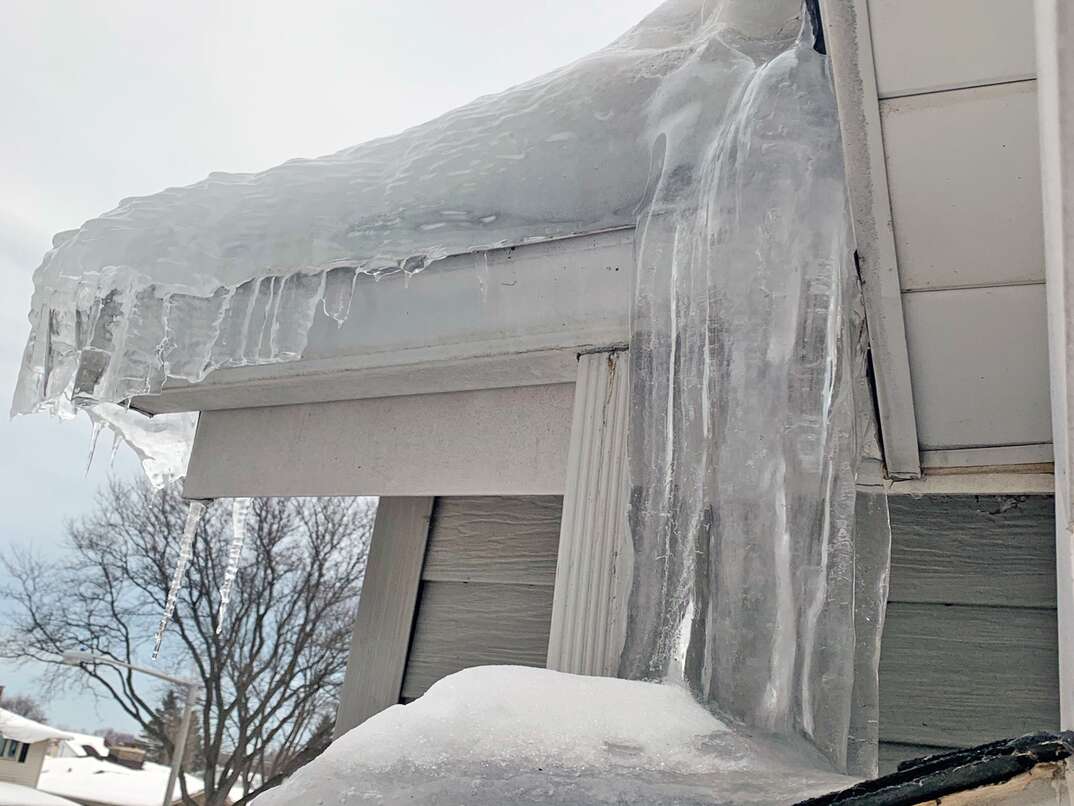How Do Ice Dams Form (and How Do I Remove Them)?

Icicles dangling off your roof may look beautiful, but they can also be a sign of an ice dam.
These accumulations of ice can cause major headaches for homeowners in colder climates. Here’s how to keep your home safe.
What Is an Ice Dam?
An ice dam is a mass of ice that forms along the edge of your roof. The ice ridge creates a blockage of ice, which can trap melting snow and keep it on your roof. If you don't do anything about them, ice dams can continue to grow as snow melts and refreezes.
The problem typically starts with warm air in your attic or the highest level in your home. That heat causes snow on your roof to melt, but cold outdoor temperatures can cause the water to refreeze, especially if your gutters are full and the water can't drain away. The ice forms a ridge along the edge of the roof that can continue growing as more snow melts.
Why Are Ice Dams Dangerous?
An ice dam can cause serious damage to your roof and the rest of your home. Since it forms near the edge of the roof, the ice dam can bend or tear off your gutters and damage your shingles. If the ice dam grows too large, the excess weight could cause structural damage or a roof collapse.
Ice damming can also cause water to trickle into your home. This happens when snow or ice melts but can't run off the roof because the ice dam blocks it. If it finds a crack in the roof, that water can flow into your attic, where it can cause mold, mildew and water damage. Sometimes, it can run down through the exterior walls or go through your attic and into your main living area.
More Related Articles:
- How Much Does a Home Inspection Cost?
- 4 Tips for Hiring a General Contractor for Your Next Remodeling Project
- Should You Hire a Contractor or a Handyman?
- 5 Things to Look For When You're Hiring an Electrician
- What to Look for When Hiring an Exterminator
How Do You Remove Ice Dams?
Removing an ice dam yourself is risky. Any roof work comes with the risk of falling, but the added slipperiness of ice and snow makes ice dam removal even more dangerous. The safest option is to hire a professional to do the work. They have special equipment to remove the ice dams, and they know how to work around roofs safely.
Steam is a common method used for ice dam removal. This is a professional solution using specialty equipment that directs low-pressure steam toward the ice using a nozzle.
Commercial ice melt products made with calcium chloride can work. However, the chemicals in ice melt can damage roofing materials, particularly metal parts such as gutters and downspouts. You might also notice that the runoff damages the plants in your landscaping. One alternative is putting the ice melt in the leg of a pair of pantyhose. Then, place it on the ice dam and over the gutter. This melts the ice and creates channels running down the roof to the gutter to give the water a place to go.
It's possible to remove the ice physically by breaking up the chunks. However, pounding on the ice with a mallet comes with its share of risks. First, you could injure yourself if you fall from the roof or ice falls on you. There's also the risk of damaging your roof with the mallet.
Can You Prevent Ice Dams?
There are ways to prevent ice damming so you don't have to worry about the damage. Here are some strategies:
- Clear the gutters: If your gutters are full of fall leaves, melting snow and ice can't run through them, which can keep the water there to freeze.
- Insulate your attic: Improving attic insulation prevents the warmer air from reaching your roof, which can keep the snow from melting quickly without anywhere to go.
- Add ventilation: A related strategy is improving attic ventilation. That helps keep cold air circulating under the roof to prevent the snow from melting and forming ice dams.
- Use a roof rake: This specialty tool has a long handle and allows you to remove snow from your roof. This can eliminate the worry of the snow melting and refreezing.
- Install heated cables: These cables can prevent ice dams from forming when they're installed along the edge of your roof.
Consulting with a roofing company can help you come up with the best solutions to prevent ice damming on your roof.
Elocal Editorial Content is for educational and entertainment purposes only. Editorial Content should not be used as a substitute for advice from a licensed professional in your state reviewing your issue. Systems, equipment, issues and circumstances vary. Follow the manufacturer's safety precautions. The opinions, beliefs and viewpoints expressed by the eLocal Editorial Team and other third-party content providers do not necessarily reflect the opinions, beliefs and viewpoints of eLocal or its affiliate companies. Use of the Blog is subject to the
Website Terms and Conditions.The eLocal Editorial Team operates independently of eLocal USA's marketing and sales decisions.



